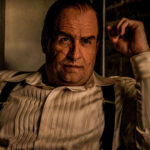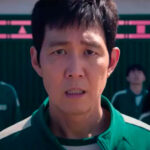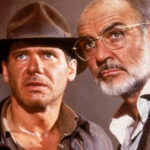

Since its release in 1981, “Indiana Jones and the Raiders of the Lost Ark” has captivated audiences with its thrilling blend of adventure, action, and historical intrigue. Directed by Steven Spielberg and starring Harrison Ford in the iconic role of the intrepid archaeologist, the film not only enchants with its exciting narrative but is also packed with fascinating trivia that sheds light on the behind-the-scenes production and reveals secrets behind its most memorable scenes. From ingenious camera tricks to remarkable improvisations, join us on this journey to uncover the secrets behind the making of this cinematic classic.
1 – IT ALL STARTED AT THE DENTIST
When George Lucas sought Philip Kaufman’s collaboration in crafting a narrative inspired by the adventures of his childhood heroes, he recalled a story shared by his dentist when he was 11 years old. This story recounted the biblical legend of the Lost Ark, which housed the Ten Commandments. The proposal was so well-received that Lucas suggested this be the title of the story.
Subsequently, when presenting the project to Steven Spielberg, whose Jewish beliefs were well-known, the fact that he was working on a story that explored a significant element of his religion while portraying the Nazis as antagonists sparked Spielberg’s interest and enthusiasm for the project.
2 – THE NAME WAS BASED ON GEORGE LUCAS’S DOG
In George Lucas’s initial conception, the fearless cinema hero would be named Indiana Smith. However, Spielberg wasn’t particularly fond of this name, arguing that “Professor Smith” didn’t have the same resonance. Thus, he suggested the surname “Jones,” which sounded more fitting. Interestingly, the name “Indiana” remained unquestioned, being a tribute to George Lucas’s own dog, named Indiana.
This connection is later referenced in the conclusion of “Indiana Jones and the Last Crusade” (1989). Furthermore, Lucas’s Alaskan Malamute’s face served as inspiration for the facial modeling of another beloved Hollywood character, Chewbacca.
3 – THE ADVENTURER OF MACHU PICCHU
With his stubbled chin, a weathered felt hat, a rugged leather jacket, and a fabric satchel to hold the most precious treasures, along with his whip, Indiana Jones embodies the spirit of the explorer. Lucas and Spielberg drew special inspiration from the American archaeologist Hiram Bingham, credited with discovering the ruins of Machu Picchu in Peru. They also drew inspiration from Tintin and Clint Eastwood’s Western films.
4 – HARRISON FORD WASN’T THE ONLY OPTION TO PLAY THE MOST FAMOUS ARCHAEOLOGIST IN CINEMA
For the role of Indiana, Spielberg had Harrison Ford in mind, but Lucas had his doubts as the audience associated the actor with the character Han Solo from “Star Wars”. The two directors also considered Nick Nolte, Jeff Bridges, and Bill Murray, and finally, Tom Selleck, who was less prominent at the time. However, Selleck was committed to the TV series “Magnum”. Spielberg eventually managed to convince Lucas that Harrison Ford was the right choice.
5 – OPENING BASED ON A UNCLE SCROOGE STORY
The iconic opening sequence, where Indy navigates through a cave in the Amazon and finds himself forced to flee from an imposing rolling boulder, was a suggestion from Steven Spielberg. Initially, George Lucas envisioned that the film’s opening scene would involve a submarine and a monkey performing the Nazi salute.
However, Spielberg had an inspiration when recalling a Uncle Scrooge comic story titled “The Seven Cities of Cibola,” published in 1954. In this story, a giant stone is triggered after a thief attempts to steal an emerald idol from Cibola. Drawing from this reference, they brought to life one of the most memorable opening sequences in cinema.
6 – HARRISON FORD’S IMPROVISATION
One of the most iconic scenes in the film features Indiana confronting a Bedouin swordsman who challenges him to a sword fight. Initially planned as a long and elaborate fight sequence, the scene underwent a last-minute alteration due to Harrison Ford’s discomfort, as he was suffering from severe dysentery. In a moment of spontaneous inspiration just before filming, Ford approached Spielberg and proposed, “Why don’t I just shoot him?”.
At first, the crew thought it was a joke, but Spielberg saw potential in the idea and directed the scene with the quick resolution suggested by Ford, making this moment memorable in cinema history.
7 – THE OUTFIT HAD TO BE VERY DIRTY
The iconic look of Indiana Jones was created in a rather peculiar way. The famous hat was acquired in London, but to give it the appearance of having gone through numerous adventures, several crew members, including Steven Spielberg and Harrison Ford, had to sit on it for a few days. Similarly, the ten leather jackets that arrived in the dressing room were in perfect condition. To age them, costume designer Deborah Nadoolman Landis used a dagger and a metal brush to distress them.
8 – THE SNAKE PIT SCENE
The sequence in which Indy and Marion are thrown into a pit full of snakes was filmed in London, in the same studio used to create Jack Torrance’s room in “The Shining” (1980). To fill the space with snakes, the crew needed 10,000 animals, so they scoured all the pet shops in London and also the areas south of England.
The challenge was that, even with a large number of snakes in the studio, Spielberg still didn’t have enough to create the desired effect. As a solution, they mixed the animals with various pairs of cut-off pant legs to give the impression of a larger number of snakes. Despite so many reptiles, only one crew member was bitten by a python. Surprisingly, despite not being afraid of snakes, Harrison Ford felt sick and almost vomited due to the effect of them moving across the floor.
9 – MAKING A CINEMATIC DEBUT
This film marked the cinematic debut of the talented Alfred Molina (known for his role in “Spider-Man 2”). At that time, at 28 years old, he made a brief appearance right in the opening sequence, playing the character who guides and betrays Indy in the cave. In another scene involving animals, there’s a moment where he is covered in tarantulas. All of them were males and remained still on Alfred’s body. To agitate them without posing a threat to the actor, the production used a female tarantula, which managed to stir the arachnids, achieving the desired effect by Spielberg.
10 – STAR WARS SETTING
Near the end of the film, the hero threatens to destroy the Ark of the Covenant with a bazooka. The gorge used as a setting is located in Tunisia and was also used as a filming location for “A New Hope” (1977), representing one of Tatooine’s gorges. It’s at this location that the droid R2-D2 suffers a malfunction and falls.
“Indiana Jones and the Raiders of the Lost Ark” remains not only a classic in adventure cinema but also an endless source of curiosities and fascinating details. From casting choices to the challenges faced during filming, every aspect of this iconic film reveals the dedication and creativity of the entire team involved. Behind the spectacular action scenes and memorable moments, we find surprising stories, such as inspiration from real-life figures and ingenious tricks used to create impressive visual effects. These curiosities not only enrich our appreciation for the film but also invite us to delve deeper into the universe of Indiana Jones, where mystery and adventure never cease.








